| کد مقاله | کد نشریه | سال انتشار | مقاله انگلیسی | نسخه تمام متن |
|---|---|---|---|---|
| 4716136 | 1638683 | 2014 | 15 صفحه PDF | دانلود رایگان |

• Metasomatic amphibole and phlogopite widely occur in the Oeyama forearc ophiolite.
• Temperature condition for the metasomatism was estimated to be 650–750 °C.
• Mylonitization of hydrous peridotites occurred at temperatures similar to those of the metasomatism.
• Heterogeneous olivine compositions suggest rapid cooling after metasomatic veining.
• All the data suggest exhumation immediately after the metasomatic fluid infiltration.
In contrast to the widely recognized aspects of serpentinization, initial stages of hydration and tectonic processes of unserpentinized peridotites are still unclear, but have important implications for understanding the lithospheric architecture of supra-subduction zones. This study provides petrological evidence from the Oeyama ophiolite, SW Japan, of the effects of high-temperature metasomatic hydration immediately before the cooling and ductile deformation of forearc peridotites. Key findings in this study are: 1) complex association of high-temperature metasomatic minerals: tremolitic amphibole, cummingtonite, phlogopite, chlorite, olivine and orthopyroxene in veins and in mylonites; 2) the systematic variation in Si and Na + K contents of the tremolitic amphibole, corresponding to its mode of occurrence and mineral association; and 3) the presence of thin (< 0.7 mm) veins of fine-grained olivine accompanied by a narrow diffusion zone of the host primary olivine. On the basis of petrography and mineral chemistry, the temporal sequence of hydration and deformation of the Oeyama ophiolite is considered as follows: 1) infiltration of slab-derived fluids, causing decomposition of primary pyroxene and chemical modification of primary olivine, 2) metasomatic formation of variable modal amounts of amphibole, phlogopite, chlorite, vein-forming olivine and secondary orthopyroxene at 650–750 °C; 3) early-stage mylonitization of the hydrous peridotites in localized shear zones; and 4) syntectonic serpentinization at 400–600 °C to form serpentinite mylonites. Paragenesis and amphibole compositions suggest comparable temperature conditions for metasomatism and early-stage mylonitization. Mylonitization occurred exclusively in hydrous peridotites, and the peridotite mylonites were preferentially overprinted by syntectonic serpentinization. Diffusion profiles of olivine cut by a vein suggest rapid cooling immediately after the metasomatic fluid infiltration. From these observations and calculations, it is concluded that the exhumation of the forearc peridotites was closely related to the infiltration of high-temperature metasomatic fluids and hydration occurred under a wide range of temperature conditions.
Journal: Lithos - Volumes 184–187, January 2014, Pages 346–360